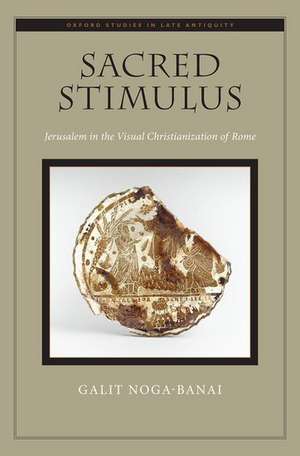Sacred Stimulus: Jerusalem in the Visual Christianization of Rome: Oxford Studies in Late Antiquity
Autor Galit Noga-Banaien Limba Engleză Hardback – 12 iul 2018
Din seria Oxford Studies in Late Antiquity
- 23%
 Preț: 805.97 lei
Preț: 805.97 lei - 19%
 Preț: 497.85 lei
Preț: 497.85 lei - 9%
 Preț: 220.13 lei
Preț: 220.13 lei - 28%
 Preț: 485.80 lei
Preț: 485.80 lei - 27%
 Preț: 489.52 lei
Preț: 489.52 lei - 28%
 Preț: 484.96 lei
Preț: 484.96 lei - 25%
 Preț: 642.83 lei
Preț: 642.83 lei - 22%
 Preț: 379.88 lei
Preț: 379.88 lei - 30%
 Preț: 613.70 lei
Preț: 613.70 lei - 30%
 Preț: 612.48 lei
Preț: 612.48 lei - 30%
 Preț: 550.85 lei
Preț: 550.85 lei - 30%
 Preț: 647.57 lei
Preț: 647.57 lei - 30%
 Preț: 764.48 lei
Preț: 764.48 lei - 30%
 Preț: 633.36 lei
Preț: 633.36 lei - 27%
 Preț: 494.48 lei
Preț: 494.48 lei - 27%
 Preț: 599.66 lei
Preț: 599.66 lei - 13%
 Preț: 604.61 lei
Preț: 604.61 lei - 16%
 Preț: 574.64 lei
Preț: 574.64 lei
Preț: 492.61 lei
Preț vechi: 680.73 lei
-28% Nou
Puncte Express: 739
Preț estimativ în valută:
94.27€ • 97.86$ • 78.61£
94.27€ • 97.86$ • 78.61£
Carte tipărită la comandă
Livrare economică 12-18 martie
Preluare comenzi: 021 569.72.76
Specificații
ISBN-13: 9780190874650
ISBN-10: 0190874651
Pagini: 256
Dimensiuni: 236 x 160 x 18 mm
Greutate: 0.54 kg
Editura: Oxford University Press
Colecția OUP USA
Seria Oxford Studies in Late Antiquity
Locul publicării:New York, United States
ISBN-10: 0190874651
Pagini: 256
Dimensiuni: 236 x 160 x 18 mm
Greutate: 0.54 kg
Editura: Oxford University Press
Colecția OUP USA
Seria Oxford Studies in Late Antiquity
Locul publicării:New York, United States
Recenzii
Her careful reading of a variety of portable objects, funerary art, monumental pictorial programs, and architecture provides a new way of envisioning the visual development of Rome's sacred topography.
This exciting new monograph assesses the visual effect Jerusalem had on the making of Christian art in Rome from the first to the fifth century. No other book would parallel the Arch of Titus and the epigrams of Bishop Damasus -- Noga-Banai does this with brio and with solid argumentation to prove her thesis that the cultic and cultural memory of Jerusalem triggered new artistic solutions in Rome. The mnemonic bridges that the Church of Rome established with Jerusalem served to create the illusion of historical continuity and the appropriation of the status of 'holy city.'
Noga-Banai's subject is excellent and innovative ... Should be a welcome addition to studies of the city of Rome and its Christian monumentalization, and a very good explanation on why we should consider visual knowledge side by side with textual knowledge.
When words fail images step up. Sacred Stimulus turns a finely-tuned ear to the faint echoes of a once strident conversation. In the visual polemics that Galit Noga-Banai detects in such works as the Samagher Casket, the Bethesda sarcophagi, and the apse mosaic of S. Pudenziana, she recognizes the designs of Roman patrons and artists intent on relocating Jerusalem to the banks of the Tiber. What surfaces is an adventurous romp through the loca sancta of two preeminent late antique cities and a new way of seeing familiar things.
This exciting new monograph assesses the visual effect Jerusalem had on the making of Christian art in Rome from the first to the fifth century. No other book would parallel the Arch of Titus and the epigrams of Bishop Damasus -- Noga-Banai does this with brio and with solid argumentation to prove her thesis that the cultic and cultural memory of Jerusalem triggered new artistic solutions in Rome. The mnemonic bridges that the Church of Rome established with Jerusalem served to create the illusion of historical continuity and the appropriation of the status of 'holy city.'
Noga-Banai's subject is excellent and innovative ... Should be a welcome addition to studies of the city of Rome and its Christian monumentalization, and a very good explanation on why we should consider visual knowledge side by side with textual knowledge.
When words fail images step up. Sacred Stimulus turns a finely-tuned ear to the faint echoes of a once strident conversation. In the visual polemics that Galit Noga-Banai detects in such works as the Samagher Casket, the Bethesda sarcophagi, and the apse mosaic of S. Pudenziana, she recognizes the designs of Roman patrons and artists intent on relocating Jerusalem to the banks of the Tiber. What surfaces is an adventurous romp through the loca sancta of two preeminent late antique cities and a new way of seeing familiar things.
Notă biografică
Galit Noga-Banai is of the History of Art department at The Hebrew University of Jerusalem and author of The Trophies of the Martyrs: An Art Historical Study of Early Christian Silver Reliquaries (OUP 2008).
